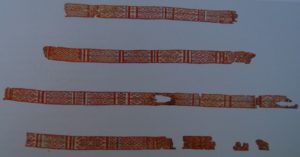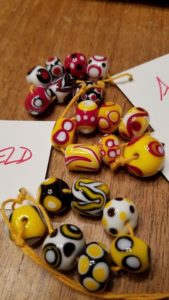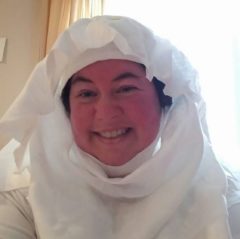The last few weeks have been a flurry of research for teaching a class at An Tir Collegium on A Brief Survey of Tablet Woven Bands, being an overview of extant tablet weaving pieces and patterns to reproduce them. It was a few weeks of preparation prior to the class, but I was able to put together a 50+ slide PowerPoint presentation. It had pieces from 500 BC Austria to 14th century Germany, and from countries all over Europe from Scandinavia to France. I arrived in the classroom a few minutes early, but spent several more struggling to get the computer to work properly. Once we made the magic of technology cooperate with me, I looked up and realized that the classroom was not just well-attended, but standing-room-only! I thought I’d have a small handful of students and it was more than 25. No worries. I’ll just panic a little. AAAAAHHHHHHH!
After we finally got the computer working, it went well! Most of the students were either novice or beginning weavers; only a couple were intermediate or advanced. The feedback I got was mostly excellent, which was very encouraging. I even was pulled aside by a couple of students later and told that they really enjoyed the class and that a few things that I mentioned were particularly helpful. 😀
A few days later, I sent a copy of the slide show to a prominent tablet weaver in Germany who gave me some really good feedback–just a couple of minor corrections and marking some images that I had missed–but she said, “It is one of the best summaries I’ve read.” That is high praise from such an esteemed source! (Giddiness ensued!)
My goal for teaching the class was to have as many pieces done in my own hand as possible. The more slides I added, the fewer examples I had…so I needed to get some work done. In preparation for this class, I made a few woven pieces to pass around. They are:

14th Century German piece. Original was brocade (of course), but this is a very close facsimile in a threaded-in version. This one was still on the loom, which was great for students to see all set up with all the cards needed for it…all 28 cards.

Dublin Dragons. Original was also brocaded. I think this is even prettier than the original. It’s great fun to weave, too!

Hallstat 3, Austria, 500 BCE. This was found in a salt mine with several other woven pieces. The colors were remarkably well preserved due to the salt. This one was fast and lovely to work, and I find it so remarkable how complex the pattern is, and this in 500 BCE…the technique was already very advanced at this time. In Mistress Madrun’s class, she mentioned how much our weaving skills have declined in the last few centuries compared to what it was back then.

Right now I’m working on a piece that has a repeating motif from the Merovingian Queen Bathilde in Chelles, France (above). I’m not as impressed with this selection of colors (below), but I wanted to choose something from my badge/arms. I think the blue and green are too similar in tone, or maybe there is too much contrast with the green and white. I’m not entirely sure, but I have a taker for it when I finish the other 3 yards of it. It’s kind of slow going and the twist is building up on it rather quickly. This would work much better in a warp-weighted version, if I had something set up to work on.

I have a list of about 20 other pieces in a binder, ready to go, that I’m looking forward to making, and a few patterns that I plan to make more than one length of, in various colors.
While I was getting ready to teach, I also had a commitment to make beads for the Lampworkers Guild. These are for Aethelmarc, Northshield and Avacal. Each grouping has one bead for An Tir’s sitting Queen and the others are gifts to the Queens of other Kingdoms, which I believe are sent to them at events in February and August.

Now that all that is done….I need a long sleep.

